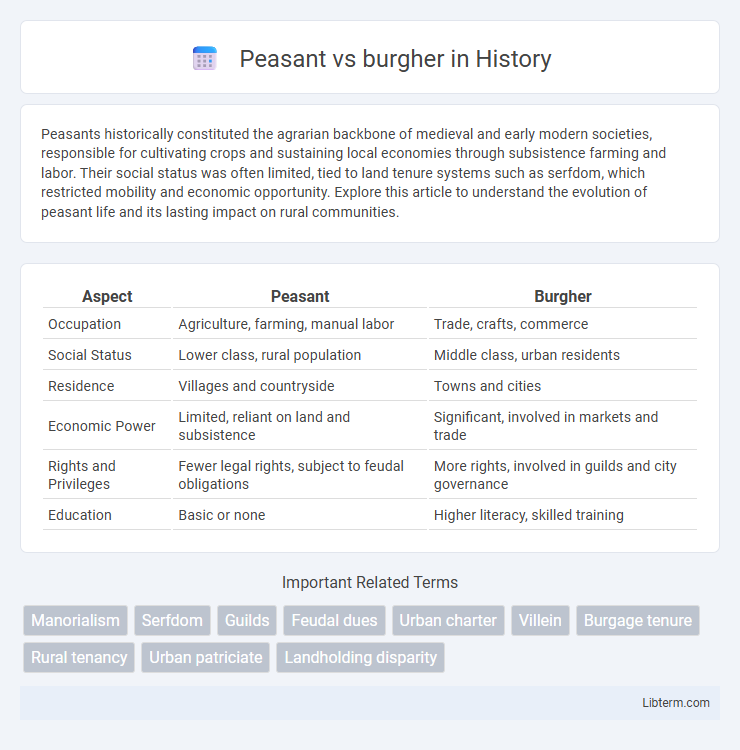Peasants historically constituted the agrarian backbone of medieval and early modern societies, responsible for cultivating crops and sustaining local economies through subsistence farming and labor. Their social status was often limited, tied to land tenure systems such as serfdom, which restricted mobility and economic opportunity. Explore this article to understand the evolution of peasant life and its lasting impact on rural communities.
Table of Comparison
| Aspect | Peasant | Burgher |
|---|---|---|
| Occupation | Agriculture, farming, manual labor | Trade, crafts, commerce |
| Social Status | Lower class, rural population | Middle class, urban residents |
| Residence | Villages and countryside | Towns and cities |
| Economic Power | Limited, reliant on land and subsistence | Significant, involved in markets and trade |
| Rights and Privileges | Fewer legal rights, subject to feudal obligations | More rights, involved in guilds and city governance |
| Education | Basic or none | Higher literacy, skilled training |
Introduction to Peasant and Burgher Classes
Peasants were predominantly rural agricultural laborers who lived under feudal obligations and contributed to local economies through farming and subsistence activities. Burghers, on the other hand, were members of urban middle classes in medieval towns, engaged in trade, commerce, and skilled crafts, playing a key role in the development of market economies. The distinction between peasants and burghers highlights the economic and social divide between rural agrarian communities and burgeoning urban centers during the Middle Ages.
Historical Origins of Peasants and Burghers
Peasants originated as rural agricultural laborers tied to feudal lands in medieval Europe, sustaining local economies through subsistence farming and tribute payments to lords. Burghers emerged in the High Middle Ages as urban middle-class citizens, including merchants and craftsmen, who drove economic growth within fortified towns and gained political influence through guilds and town charters. The distinct social roles of peasants and burghers reflected the evolving feudal system and the rise of market-oriented economies in medieval Europe.
Social Structure and Class Distinctions
Peasants occupied the lower tier of the medieval social hierarchy, primarily engaged in agricultural labor under feudal obligations, often lacking land ownership and legal rights. Burghers, as urban middle-class inhabitants, held economic influence through trade, crafts, and guild memberships, contributing to the emerging capitalist economy in towns. This distinct social structure created clear class distinctions, with peasants tied to rural manors and burghers gaining political autonomy and wealth in urban centers.
Economic Roles in Medieval Society
Peasants in medieval society primarily engaged in agriculture, producing essential food crops and livestock that sustained local economies and feudal hierarchies. Burghers, as urban middle-class inhabitants, dominated trade, crafts, and commerce, facilitating market growth and economic diversification in medieval towns. This division of labor underscored the economic foundation of feudalism, with peasants supporting agrarian production while burghers advanced market economy development.
Daily Life: Peasant vs. Burgher
Peasants engaged in arduous agricultural labor, living in modest homes with limited access to hygiene and sanitation, while burghers enjoyed urban life with better infrastructure, including paved streets and public markets. Peasants' diets mainly consisted of coarse bread, vegetables, and occasional meat, contrasting with burghers who had access to diverse foods like cheese, spices, and wine. Burghers had more leisure time and participated in guilds and city governance, whereas peasants faced heavy taxation and obligations to local lords, limiting their social mobility.
Rights, Privileges, and Legal Status
Peasants were generally bound to the land under feudal law, possessing limited rights and facing obligations such as labor dues and taxes, with little legal protection or ability to own property independently. Burghers, as town dwellers and members of the emerging middle class, enjoyed distinct privileges including self-governance in municipal courts, rights to trade and property ownership, and relative legal autonomy through charters granted by local lords or monarchs. These legal distinctions underscored a social hierarchy where burghers' economic activities and rights enabled greater social mobility compared to the hereditary and servile status of peasants.
Urban vs. Rural Lifestyles
Peasants typically led rural lifestyles centered on agriculture, subsisting through farming, animal husbandry, and seasonal labor, often facing harsher economic conditions and limited access to resources. Burghers inhabited urban environments, engaging in commerce, crafts, and guild activities, benefiting from greater economic opportunities, social mobility, and access to markets and city infrastructure. The contrast between peasant and burgher lifestyles highlights the economic and social divide between rural agricultural dependence and urban mercantile communities in medieval and early modern societies.
Access to Education and Literacy
Peasants typically had limited access to education, often restricted to basic oral traditions and practical skills necessary for agricultural labor, resulting in low literacy rates. Burghers, as members of the urban middle class, had greater opportunities to attend schools, learn reading and writing, and engage in commerce or administration, which significantly increased their literacy. This educational disparity reinforced social divisions and influenced economic mobility during the medieval and early modern periods.
Political Influence and Social Mobility
Peasants held limited political influence, often subject to the authority of feudal lords, while burghers exercised greater power through urban councils and guilds, shaping local governance. Social mobility was restricted for peasants due to rigid feudal hierarchies, contrasting with burghers who could ascend economically and socially by gaining wealth and civic status. The burgher class's engagement in trade and commerce enabled them to challenge traditional noble privileges, gradually altering medieval societal structures.
Lasting Impact on Modern Society
Peasants and burghers shaped the foundation of modern social and economic structures, with peasants representing agrarian labor crucial to sustaining feudal economies and burghers driving urban commerce and the rise of capitalism. The peasant class influenced land use patterns and rural traditions still evident in contemporary agricultural practices, while burghers contributed to the growth of market economies, municipal governance, and the emergence of the middle class. Their lasting impact is visible in modern social hierarchies, property rights, and economic diversification that underpin today's societal organization.
Peasant Infographic

 libterm.com
libterm.com